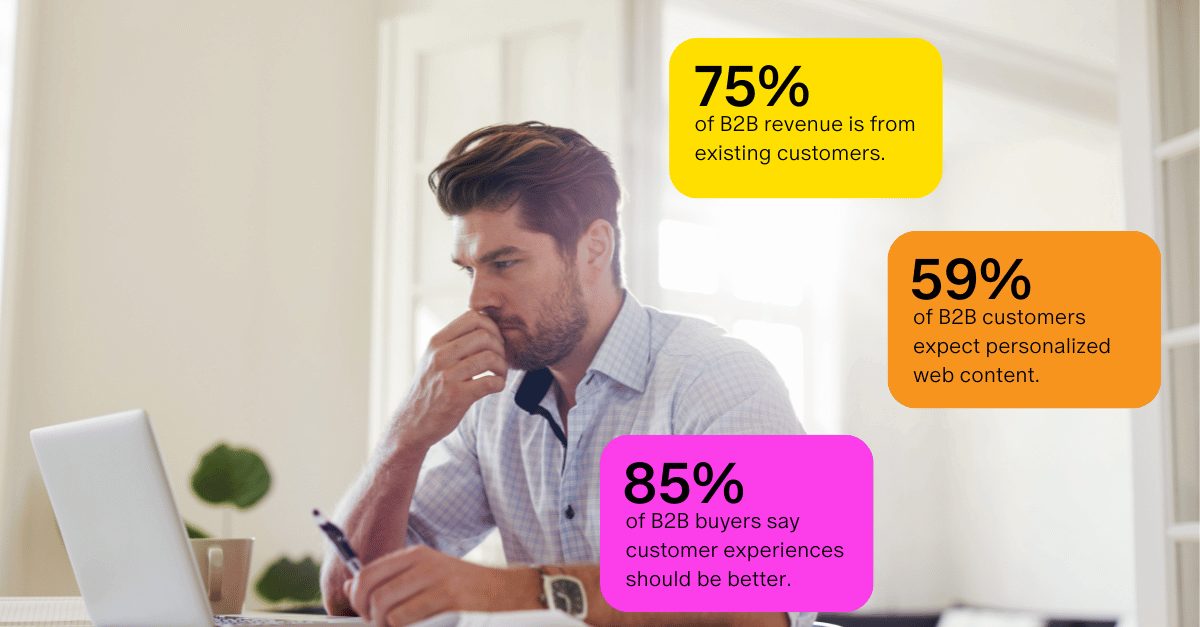Ready to dive into some eye-opening B2B marketing statistics? We’ve gathered the latest figures that every channel marketer should know to stay on top of their game. Whether you’re crafting strategies for customer engagement, fine-tuning your sales tactics, or amplifying your content across various channels, these B2B marketing statistics shed light on what’s working in the fast-evolving world of marketing.
Here’s what you can expect:
We’ll start with some crucial B2B marketing statistics on Customer Engagement and Experience—just how connected do your customers feel to your brand?
Next, we’ll explore the impact of Corporate and Personal Values on buying decisions, revealing a shift towards more personal and emotionally resonant marketing.
Moving on, we’ll look at Channel Sales—how well are companies meeting the expectations of savvy business buyers?
And we can’t forget about Partner Marketing, where collaboration can catapult your reach and results.
Finally, we’ll discuss the importance of Marketing Channels and Content, highlighting the most effective ways to catch and keep your audience’s attention.
So, buckle up! Whether you’re looking to refine your approach or just curious about the current landscape, these B2B marketing statistics are your roadmap to more informed, effective marketing strategies. Let’s get started!
Key 2024 B2B Marketing Statistics
Customer Engagement and Customer Experience
- Only 29% of B2B customers are engaged, while 60% are indifferent and 11% are actively disengaged. (Gallup)
- B2C companies average a 65-85% customer experience score, while B2B companies average less than 50%. (McKinsey)
- 78% of customers expect companies to adapt to their changing needs/preferences. (Salesforce)
- 46% of of business buyers say most companies treat them as a number. (Salesforce)
- 85% of business buyers say customer experiences should be better considering all the data companies collect. (Salesforce)
- 65% of millennials and 61% of Gen Z prefer to engage digitally, vs. 38% of boomers and 54% of Gen X who prefer the same. (Salesforce)
- 76% of B2B buyers expect personalized attention from solution providers based on specific needs. (Gallup)
Corporate and Personal Values
- B2B buyers are about 50% more likely to buy a product or service when they see personal value—such as opportunity for career advancement or confidence and pride in their choice—in their business purchase decision. (Think with Google)
- Business value (functional benefits, business outcomes) has a 21.4% impact on commercial outcomes, vs. personal value (professional benefits, social benefits, emotional benefits, self-image benefits), which has a 42.6% impact. (CEB/Think with Google)
- B2B buyers are 8x more likely to pay a premium for comparable products and services when personal value is present. (Think with Google)
- 86% of customers expect companies to clearly state their values. (Salesforce)
Channel Sales
- 86% of business buyers are more likely to buy if companies understand their goals, but only 59% say most sales reps don’t take the time to understand them. (Salesforce)
- 84% of business buyers expect sales reps to act as trusted advisors, but 73% say most sales interactions feel transactional. (Salesforce)
- 84% of of B2B decision-makers start the buying process with a referral. (B2B News Network)
- 80% of marketers say they’ve noticed an uptick in sales after adding video content. (Zippia)
Partner Marketing
- 84% of top-quartile companies that outperform their peers invest in co-marketing. (McKinsey)
- Only 12% of partners use brand-provided through channel marketing automation platforms. (Extu & Forrester study)
- A Demand Gen webinar shared that partners’ top 3 motivations for participating in vendor programs are:
- Product/solution development (52%)
- Staff support, training, and enablement (50%)
- Product/solution enhancement (47%)
Marketing Channels and Content
- According to the LinkedIn B2B Benchmark, the 4 most important marketing channels for B2B marketers are:
- In-person events (60%)
- Video (59%)
- Thought leadership (57%)
- Digital events (49%)
- 45% of B2B buyers want personalized content portals. (Zippia)
- 59% of B2B customers expect personalized website content. (MarketingCharts)
- According to Demand Gen Report’s 2023 Content Preferences Survey, the top content formats that B2B buyers find most appealing are
- Infographics and blogs (65%)
- Webinars and digital events (52%)
- White papers and ebooks (50%)
Customer Loyalty
- 86% of distributors see little to no difference between manufacturers. (Think with Google)
- 75% of B2B sales leaders say that leads referred from loyal customers are more likely to close. (Heinz)
- Businesses have a 60 to 70% chance of selling to an existing customer while the probability of selling to a new prospect is only 5% to 20%. (Forbes)
- When it comes to company, individual, and industry personalization, emails that combine personal + company information have the highest open rates (26%). However, emails that offer personalized industry content have the highest click-through rate (6%). (CorporateVisions)
- A majority of consumers say they’d use loyalty programs more if companies fixed the difficulty of tracking rewards and manually redeeming them. Additionally, 55% would use programs more if rewards were personalized, better reflecting their individual needs. (Salesforce)
- 83% of customers say they’re more loyal to companies that provide consistency across departments. (Salesforce)
- Customer acquisition is 5 to 25 times more expensive than customer retention. (Harvard Business Review)
- Increasing customer retention by just 5% can yield a 25% increase in profit. (Bain & Company).
- Loyalty program emails have 233% higher click rates than the B2B email marketing average. (Case Study)
- Business from existing customers makes up over 75% of the average B2B revenue stream. (Forrester)



